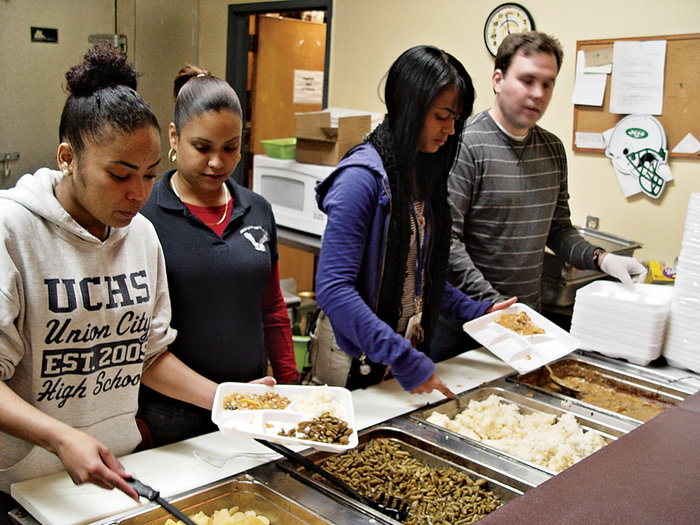Around 20 Union City High School Alternative Design Academy (ADA) students, trays of food in hand, weaved between the near 100 guests who had come to the Palisades Emergency Residency Corp (P.E.R.C.) shelter on 36th Street for a hot meal last Monday. The volunteers placed the trays in front of some diners even before they could sit down, and they served up dinners like seasoned restaurateurs.
“These kids are good,” Program Director and 40-year shelter advocate veteran Tom Harrigan said. “When I worked at my sister’s restaurant in Hoboken, she fired me.”
He has seen many students work the dinner shift at the shelter in his career, and in his experience, some take to it better than others. Harrigan had a theory as to why the ADA students did so well.
“It hits close to home,” he said.
“Whether it’s bad choices or bad luck, everyone deserves a second chance.” – Willie Benavives
____________
“I’ve seen a lot of bad things happen to my own family, and we’ve pulled through,” she explained. “I don’t want to be in the same situation, and I want to give back to my community.”
ADA students have increasingly ramped up their community service this past year. The student council, also in its first year, began the initiative with a Christmas toy drive in December, and collected coats for the victims of the eight-alarm Bergenline Avenue fire back in January.
They were so successful that they donated the excess to P.E.R.C. and received a letter of thanks from Executive Director Emory Edwards for their efforts. This, in combination with social worker and Student Council Advisor Eric Williams’ longstanding ties with the shelter, inspired them to donate their time as well.
“Mr. Williams has worked with P.E.R.C. for years, and my grandmother has ties to the shelter too,” Student Council President Krystal Perez said as she fed the guests. “Most people think that homeless and hungry people are that way because of drugs or alcoholism. But with the lack of jobs and the poor economy, it’s hard for people to provide for their families when the government just isn’t helping enough.”
The working poor
“One of the largest growing populations that I see today is the working poor,” Harrigan told the students as they stood in the shelter’s dormitory. “Most of the people you will see at dinner have jobs and do not live here. They have jobs and are unable to buy food and pay rent at the same time.”
Average rent in the area for a one-bedroom apartment ranges between $800 and $1000 per month, he said. He asked the students how much they would make if they were to get a job without a diploma, and almost all of them immediately quoted the current minimum wage rate at $7.25 per hour.
“I’ll tell you what, I’m going to be generous and pay you $10 an hour,” Harrigan posited. “You’re going to work 40 hours a week. That gives you around $360 take-home per week.”
Assuming the students didn’t have families to support, he asked how much that would leave for living expenses for the remainder of the month.
“Not enough,” Pacheco said.
Harrigan’s scenario did not include the expense of moving into an apartment to begin with, he added. And say the minimum wage job is with a temp agency, which excludes benefits and is not secured or guaranteed.
After a brief discussion about having spent between $80 and $180 on sneakers for themselves, the students were visibly impressed.
“This is the reality that we’re trying to understand,” ADA Executive Director Annette Kaplan explained. “Right now you’re reality is that you go home, somebody makes you arroz con pollo. Tonight we’re here to learn, to help, and to give back.”
“Nobody wants to be homeless,” Harrigan said. “It’s not just drug addicts and alcoholics, especially in a time like this. How many paychecks could any one of us afford to go without?”
Why they did it
Every time 18-year-old Willie Benavives goes downtown, he sees the same homeless woman, and he gives her whatever change he can afford. She motivated him to volunteer at P.E.R.C. that night.
“I’m just trying to help out,” he said. “Whether it’s bad choices or bad luck, everyone deserves a second chance.”
“I came here to face reality, because that’s what this is,” Rockey Reyes, 17, said. “Life is a struggle and I could have landed here, but seeing this will help me make better choices.”
The teens were not the only ones with personal reasons for volunteering. Staff had their reasons, too, particularly given the nature of the school as a second chance in and of itself for its “at-risk” student population, and their choice to teach there.
“I was one paycheck away from losing my home once,” Williams said, “And then fortunately I met Ms. Kaplan and was hired by the Board of Ed.”
“It’s the cycle of a hand helping a hand helping a hand,” Kaplan said. “That’s why we’re here.”
Gennarose Pope may be reached at gpope@hudsonreporter.com
